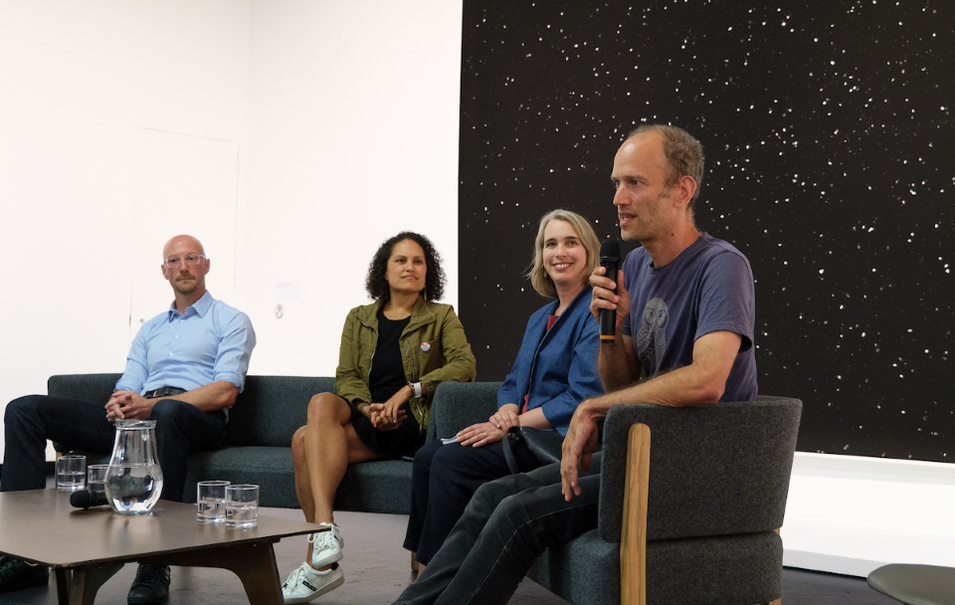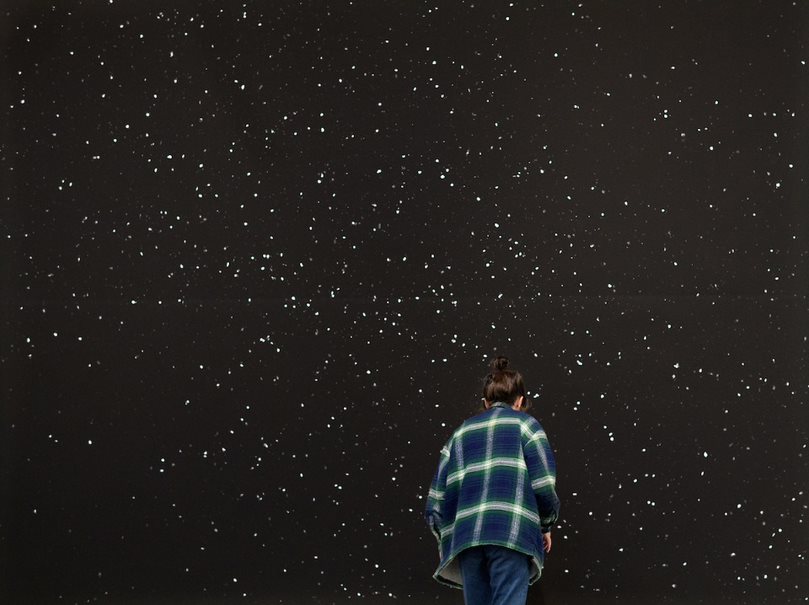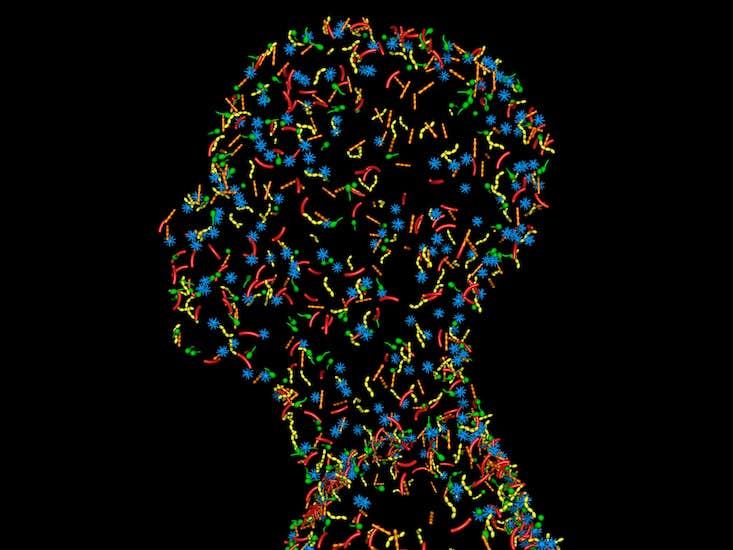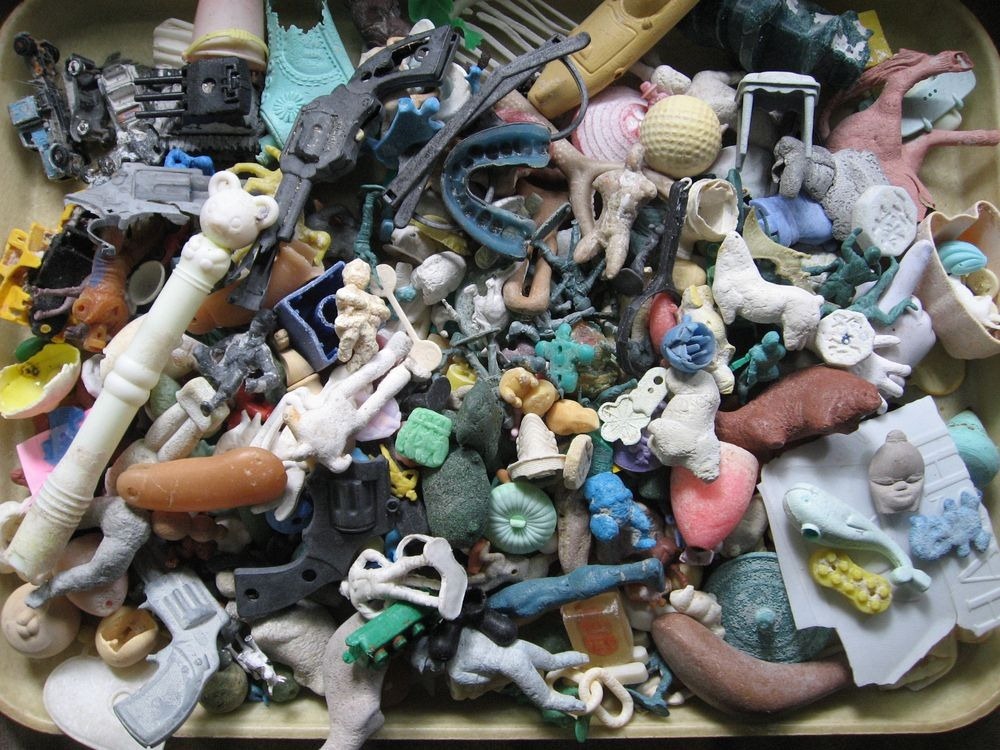.
Are we trapped by our human-centred views? On 4 February 2021, we staged a panel discussion addressing post-humanist thinking in science, art, and culture. Tim Corballis was chair. Janine Randerson, Emalani Case, and Oliver Gasser were the panellists. Robert Leonard introduced. This is what they said.

Robert Leonard: I’m Robert Leonard, Chief Curator at City Gallery and curator of the current shows, Zac Langdon-Pole: Containing Multitudes (which we are sitting in) and Simon Ingram: The Algorithmic Impulse. We’ve organised this panel discussion More than Human in response to these shows. However, the connection to these shows—and to art generally—may not be immediately apparent. So, I thought I would provide some context, before the panel digs in.
Human thinking has generally been human-centric, drawing a line between consciousness and the world, humans and everything else. That’s why animals are so perplexing for us, because we don’t know which side of the line to put them on, whether to relate to them as other sentient beings like us or as objects for us. Art has emphasised this human-centric approach, locating artists (and, by analogy, their viewers) at the sovereign centre of the world, with things arrayed for their (and our) benefit, addressed to them (and us). We have learnt to take this approach for granted. So, for me, it was profoundly disorienting to see Pierre Huyghe’s project Untilled in Documenta 13 in Kassel, Germany, back in 2012. A game-changing moment.
Untilled occupied an out-of-the way location—a dowdy area where one was not expected to go—at the edge of the otherwise scenic Karlsaue Park. I entered via a beaten track, passing piles of compost and algae-covered puddles. The site was overgrown with plants, including psychotropic, medical, and aphrodisiac ones (cannabis, deadly nightshade, and angel’s trumpets). Concrete paving slabs were stacked up matter of factly, as if waiting to be deployed elsewhere. The apparent centrepiece was a conventional sculpture of a female nude on a plinth—a replica of a 1930s work by Max Weber. But, by the time I arrived, the head had been replaced—or colonised—by a hive of bees. A greyhound called Human, with one leg painted pink, wandered around freely. Many obscure reference points—including nods to Huysmans’s novel À Rebours and Raymond Roussel’s novel Locus Solus—were apparent only by reference to a drawing in the exhibition guidebook.
Untilled didn’t look like any artwork I had ever seen—it didn’t look like art full stop. Stuff was rotting; stuff was growing; stuff was interacting; stuff was waiting to be turned into something else somewhere else. Potential was everywhere. There was no clear frame to show where the work started and stopped. It was hard to know what was in or out, what was significant and what was incidental, what had been found and what had been added by the artist. Not only was the work not addressed to me, it incorporated flora and fauna with lives and purposes of their own, engaging with this scenario alongside me on their own terms. The work seemed free to evolve or devolve, beyond any artistic intention. There was no clear drama, no spectacle, yet the effect was uncanny, even menacing. I was reminded of The Zone in Tarkovsky’s 1979 film Stalker.
Only later did I come to appreciate the full significance of Untilled, as breaking from a human-centred perspective. It heralded a new approach to art making, with more art operating in this vein appearing in its wake. Today, knowing we have brought the planet to the brink ecologically, there’s an appetite for less-chauvinistic attitudes—orientations that deprioritise human perceptions and demands. This imperative informs new philosophical approaches, such as Graham Harman’s object-oriented ontology. In different ways, Zac Langdon-Pole’s and Simon Ingram’s shows participate in this Zeitgeist. They favour decentred approaches: Langdon-Pole colliding disparate, often inhuman frames of reference (an octopus shell and a meteorite); Ingram by understanding the artist as but one node in the assemblage that produces the work.
I’m incredibly grateful to Tim Corballis for agreeing to chair this panel discussion. Please, a warm welcome for Tim.

Tim Corballis: I’m Tim Corballis, a Senior Lecturer at the Centre for Science in Society at Victoria University of Wellington and a writer, a novelist. Today, we’re going to talk about what it is to be ‘more than human’, taking some of the art on these walls as a jumping-off point. But first, I’d like to give my fellow panellists a chance to introduce themselves.
Janine Randerson: I’m Janine Randerson, a lecturer at AUT University, and chair of the Leonardo Art and Science Evening Rendezvous talks programme in Auckland. I wrote the book, Weather as Medium: Toward a Meteorological Art. I’m interested in what an art for the weather—or what an art that extends beyond our human concerns—could look like. It’s delightful to be here under Zac Langdon-Pole’s photogram of sand of the Ngāti Hei, from Cooks Beach, near Hahei, which I’ve frequented for the last forty years. That’s my grounding here.
Emalani Case: I’m Emalani Case, from Hawai’i. I’m a lecturer in Pacific Studies at Victoria University. I study and work in areas of protective action for whenua, for ‘āina. I hope to bring that into the conversation.
Oliver Gasser: I’m Oliver Gasser, a human immunologist. I lead a research group at the Malaghan Institute of Medical Research working on subjects like HIV transmutation. In the last few years, my research has been about how we need to be colonised by bacteria—especially the gut microbiome. You cannot be healthy without being colonised by trillions of bacteria.
Tim Corballis: Zac Langdon-Pole’s wall text kicks off with a well travelled Walt Whitman quote—that we ‘contain multitudes’. When Whitman wrote that, he was saying not just that we contain different perspectives and contradictory beliefs, but that we contain the cosmos within us. But, as Olivier just indicated, back then Whitman didn’t know the half of it. Today, scientists talk about the human body as an ecosystem, containing communities within it. Our cells can be understand as collaborations between bacteria. We’re all collaborative projects, not the singular, bounded individuals we like to think we are. And we extend beyond ourselves, linking with things outside us. There’s a bunch of ways in which you can see these ideas referenced in the works here. I think of Langdon-Pole’s Sleight of Hand, the jigsaw-puzzle work of a bird containing the stars perched on a human hand.
Emalani, you said the sand photograms grabbed you, initially.

Emalani Case: At first, I didn’t realise they were of sand. I thought they were shots of stars—the universe. If we talk about containing multitudes, as an indigenous person I know myself as genealogically connected to the universe. In Hawaii, we have chants about how we were birthed from pō, from darkness, from heat. So, I thought, ‘Wow, this work is like whakapapa on a page.’
When I read the label and realised it was sand, my engagement changed. In one photogram, the sand comes from Kealakekua, where I come from in Hawaii. I know it well. I know what the sand there is like. Sand is important to Hawaiians. We introduce ourselves through the ‘sands of our birth’. Because we believe ourselves to be genealogically connected to place, we have protocols around everything from sand and soil to plants and animals, where you seek permission before taking. So I thought: The artist took some sand; I wonder what processes he went through?
Then I did some reading and realised that the sand in a couple of the photograms comes from places Captain Cook landed. So, I was conflicted and I still am, but I guess that’s the point—that in a tiny grain of sand, you can see the entire universe and complex tensions in human relations.
We’re supposed to be talking about the ‘more than human’, but here I’m centralising myself. As much as we’re trying to decentre the human, there’s something about taking and decontextualising that sand that makes me ask: Who is being erased in the process? Cook went to these places and interacted with people, who are now marginalised. When we decentre the human, do we risk doubly decentring the colonised people who are already not part of the conversation? Are we again centralising Cook, by tracking his journey and not other, older migration patterns?
Tim Corballis: We’re left to think about that, aren’t we? Art works are ambiguous. We can read one as an act of violence or as a criticism of that violence. Olivier, you mentioned that Langdon-Pole’s jigsaw works recall images you show your students.
Oliver Gasser: Yes. If you Google ‘human microbiome’, you get lots of images of human-body outlines filled in with representations of bacteria. I use a slide like that with my students. Other images take human contours and mark the percentages of human cells to bacterial cells, and human genes to other genes. Obviously, it varies from individual to individual, but, in theory, we’re ten-percent human, because bacteria cells are so much smaller than human ones. The bacteria in your gut outnumber your human cells ten fold. And, if you’re looking at genes, it’s 100 fold, because humans don’t have a lot of genes.

Tim Corballis: There’s not just the gut microbiome, there’s an armpit microbiome, a hand microbiome, and a belly-button microbiome?
Oliver Gasser: Some microbiome researchers just focus on the skin. Even then, your armpit will be a different ecosystem to the top of your head—different pH, different temperature, different everything. It’s like a different continent, so you have different animals living there. The gut has the most bacteria—up to two kilos worth. And that makes sense, because we feed them all the time. We eat fibre, but can’t utilise it. It would pass straight through the gastrointestinal tract, except it’s what our bacteria use.
Your gut microbiome control your cravings. If they learn to thrive on fast food, that has a detrimental effect on your health. If you’ve ever been on a diet, you know you feel awful for a couple of weeks at the start. If you don’t hang in there—and most don’t—you go back to your old ways. The bacteria are like your kids at home. If you change what you feed them, they’re not going to be happy, right? So that feeds into the gut-brain axis. You may want to diet, but you’re not in charge of what your gut is saying: No, no, I don’t like salad; I want the burger. You contradict yourself because you contain multitudes.
Tim Corballis: Why doesn’t the brain have bacteria swimming around in there?
Oliver Gasser: It would be bad to have bacteria in the brain. You would have an encephalitis or meningitis, which are life-threatening conditions. That’s why we have a blood-brain barrier. Nothing should cross into the brain.
Tim Corballis: In talking ‘more than human’, we’re not just talking about slimy stuff and animals. We’re also talking about the weather and the atmosphere.
Janine Randerson: The more we step back and think ‘it’s not all about me’, the better we will do in this ecologically critical moment. Robert described Pierre Huyghe’s Untilled work, where he saw other stakeholders at play. There are Langdon-Pole works that suggest other points of view, like Untitled (Library), the floor of native timber, where the borer tracks have been painstakingly traced in with gold leaf. Fujiko Nakaya’s Fog Sculpture #94925: Foggy Wake in a Desert: An Ecosphere is another work that exists for non-human others. It was shown at the Biennale of Sydney in 1976 and at Melbourne’s National Gallery of Victoria in 1982. It’s now permanently installed in the sculpture garden at the National Gallery of Australia in Canberra—a dry, desert landscape. The fog only plays from noon to 2pm because of water restrictions, but it feeds a lake and indigenous trees and shrubs. While I was there, I saw crimson rosellas and other birds coming to take advantage of the moisture the work created. Air currents carry the fog over stones the artist placed in the water. Walking through it, you have a sense that nothing has edges: the trees don’t have edges, your body doesn’t have edges. Perhaps we’re always in this fog of being, interacting with other beings. In that work, I could sense the liveliness of the atmosphere.

Tim Corballis: Does the wider cosmos give the things within it meaning or do we give the wider cosmos meaning?
Emalani Case: In Hawai’i, we have stories of Wākea, our sky father, and Papahānaumoku, our earth mother. They gave birth to Hoʻohōkūkalani, the stars. Then Wākea and Hoʻohōkuūalani gave birth to the first people. Whakapapa is such a powerful tool for recognising our interconnectedness. Coming back to the world we live in today, a world in rapid decline, we have to recognise genealogical connections—not just recognise them, but act on them. It’s not a question of how far the interconnectedness goes, but how far are we willing to go to recognise that. We have to see our being stewards of the Earth as responsibility to family.
Tim Corballis: Interconnection is not always good. Cook’s voyages were a problematic form of interconnectiveness. You’ve told the story of Kamilo Beach, which also offers a strange case of interconnection.
Emalani Case: It’s on the island of Hawaii that I come from. Kamilo means to curve and to swirl. The beach was given that name because of its strong ocean currents. There are stories about people on other parts of the island throwing things into the ocean and their washing up on Kamilo Beach. There’s a story of a man who threw something into the ocean, knowing that his wife, who left him, would find it there and know he loved her. Unfortunately, Kamilo is now called ‘plastic beach’. It’s one of the most polluted beaches on Earth, because of the currents. With Hawaii’s proximity to the North Pacific Gyre and the Great Pacific Garbage Patch, Kamilo is one of the dirtiest places on the planet. I went there a few years ago and found it challenging. The currents once brought treasures and beautiful stories to the shore, but if you walk the shoreline now, you can see toothbrushes, bottles, everything, coming from places all around the world. I remember thinking: If someone else’s trash is here, where’s mine? When people think of Hawai’i, they think of clean beaches, white sand, palm trees—the ideal tourist paradise. So Kamilo is hidden. It doesn’t bring tourists in, so it’s been erased in a particularly colonial way.

Tim Corballis: How does Kamilo Beach compare with the human body? What’s washing up in us?
Oliver Gasser: We accumulate a lot of crap. One of our biggest problems is plasticisers—hydrophobic substances. If you take vitamin supplements, like water-soluble vitamin B, there’s no problem with over-supplementing, because they segregate with water and you excrete them in your urine. However, many substances are hydrophobic, which means they steadily build up in your adipose tissue, your fat. Technologically, we innovate fast, putting new substances in the environment and food chain, but we are very bad at predicting the effects.
So, if you go on a weight-loss diet, you might feel bad. That’s because you’re releasing all those accumulated toxins into your bloodstream.
Janine Randerson: We could compare the introduction of untested toxins to our bodies with human experimentation on the environment. We assume we’re past the phase when we introduced stoats into Aotearoa to catch the rabbits, despite the warnings of nineteenth-century biologists. But, in the last seven days, there’s been the issue of the red-eared slider turtles breeding at Cooks Beach. Someone thought: They’re not going to hatch; it’s too cold here. Yet they one of the world’s most successful invasive species, aside from humans.
Oliver Gasser: We do things without knowing the consequences. And it’s more or less the same with microbiome. We did not predict that a very large number of individuals born using cesarean section would develop allergies because they haven’t been colonised properly.
Tim Corballis: What percentage plastic we are?
Oliver Gasser: We could take a biopsy right now, run it through a mass spectrometer, and see what’s there. We’d see a lot of things, but what worries me most is that we don’t yet know what it may mean in terms of health or disease.
Tim Corballis: Langdon-Pole is interested in the work of the evolutionary theorist Lynn Margulis. We think of the cell as being this bounded lovely thing, but it’s not. Margulis saw about the cell—the animal cell—as originating through the combination of bacteria. Our cells contain mitochondria, which at one point would have been separate bacteria. Which leads me to think: Is there politics of the cell? Does this allow us to think about borders and boundaries more generally?
Janine Randerson: Lynn Margulis pioneered this model of symbiosis, of co-operation. It’s quite different from the competitive Darwinian model, where bacteria are seen as attacking us. When Darwin’s notion of ‘the survival of the fittest’ shifted into politics, it justified colonisation. Now we are beginning to recognise that in Aotearoa we are part of the sea of islands, Te-Moana-nui-a-Kiwa, surrounded by Moana cultural practices that resist the legacy of Euro-American anthropocentrism. I suggest in my book that contemporary-art practices also play a part in collective re-engagement our atmosphere and living biota, and with communities through communication and exchange rather than competitive models.
Oliver Gasser: Cells communicate to each other and exchange things. There are little vesicles that bud off a cell and fuse with other ones. A cell can tell a neighbouring cell, ‘Hang on, I don’t have enough energy. Can you pass me on some of your mitochondria?’ There’s fusion and information exchange all the time. Politically, that’s how the human body works. It’s not one cell saying: This is me, this is you, that’s it, there are boundaries. No. Cells fuse, they merge, they do all sorts of things. Fusion, separation, it’s happening right now, in your body. It is part of life. And it’s all based on interaction—communication. I think politics can learn something from cell biology.
Janine Randerson: A criticism of ‘more than human’ approaches—and of Bruno Latour’s actor-network-theory as a precursor—is that they flatten social and cultural difference and can obscure unequal power relations. There are still inadequacies between ‘more-than-human’ version of ecological relationality and non-Western cultural paradigms, as well as useful parallels. If all things are equal, then Covid-19 has as much of a right to survive as anything else, yet we are doing our best to halt its progress.
Tim Corballis: By ending life, Covid-19 is a bit of a failure as a virus.
Oliver Gasser: Some biologists say that a virus by itself is not alive, because it needs a host to survive. We haven’t figured out where Covid-19 comes from. From the genetic sequence, it might be from a bat. It’s a novel virus, meaning humans haven’t encountered it before. That’s why it’s so virulent and deadly. But a virus never seeks to kill its host. And, ideally, the host should get something from the virus, or at least not being harmed. If it doesn’t, it’s just a parasite, right? With the microbiome, it’s a symbiosis: the bacteria cannot live without the host, but the host gets something from it. When viruses come from the animal kingdom—HIV came from monkeys—they spread like wildfire in humans. Across time, we can potentially adapt. An evolutionary balance eventually arrives. In the meantime, if we look at it from a purely ‘more than human’ perspective, it might mean that ninety-nine percent of the population dies, and only a few individuals with particular genetic traits survive. But, that’s the evolutionary game, where two things meet up and try to see if they can live together. We are quite arrogant in thinking that, by sheer intelligence, we might survive anything.
Tim Corballis: Reaching out to the cosmos can also have a melancholy aspect, because, actually, the meteorite doesn’t pay us much attention. We think ‘let’s be friends with the animals’ and all that, but it’s not always friends, is it?
Janine Randerson: We can be confronted by nature’s crushing indifference. Yet we—particularly those of us raised in a Eurocentric paradigm—are now beginning to see ourselves as part of the ecosphere, not hovering outside it. Art can amplify our sensitivity to the stuff of the world, for its intrinsic value, rather than its value for us. I was just reading David Mitchell’s Utopia Avenue. There’s a passage in it with a talking hamburger bun. Let me read it:
The bun is a real, soft, puffy bread bun that breathes in and out and in and out. ‘Your big mistake,’ the bun tells Dean, ‘is to assume your brain generates a bubble of consciousness you call “Me”.’
‘Why is that a mistake?’ Dean asks the talking bun. ‘The truth is that you’re not your own private “I”. You are to consciousness what the flame of a match is to the Milky Way.’ …
Dean puffs a puff of air and a cloud is pushed along.
Separateness is an illusion, Dean realises. What we do to another we do to ourselves.1
Dean was having an acid trip at the time, but his insight is appropriate to our conversation.
Tim Corballis: Thinking about decentring the human, I have to keep asking if we should be decentring ourselves or recognising our interconnectedness? Interconnectedness is not always peaceful. It’s sometimes painful, even traumatic. But the survival of the planet relies upon us recognising it, and recognising our impact.
_
IMAGES Pierre Huyghe Untilled 2012; The panel, from right to left: Tim Corballis, Janine Randerson, Emalani Case, and Oliver Gasser; A visitor immersed in Zac Langdon Pole’s Te Whanganui-A-Hei / Cooks Beach 12.06.2019 2019, Chartwell Collection, Auckland Art Gallery; Microbiome graphic; Fujiko Nakaya Fog Sculpture #94925: Foggy Wake in a Desert: An Ecosphere 1982, collection National Gallery of Australia, Canberra; Plastic collected from Kamilo Beach, Hawai’i.
1. Kim Tallbear, ‘Why Interspecies Thinking Needs Indigenous Standpoints’, https://culanth.org/fieldsights/why-interspecies-thinking-needs-indigenous-standpoints.
2. David Mitchell, Utopia Avenue (London: Hodder and Stoughton, 2020), 539–40.
